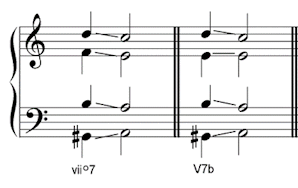Chord vii°7
Chord vii°7 is a diminished 7th chord. It is built from the diminished triad on the 7th degree of the scale, plus another third added on top: the 7th, 2nd, 4th and 6th notes of the scale.
In C major, vii°7 contains the notes B, D, F and A. Strictly speaking, this is a “half-diminished” chord, rather than “fully-diminished”, because the interval between the root and top note is a minor 7th, rather than a diminished 7th.

As a chord symbol, the above chord would be written as B°m7 (“B diminished, minor 7th”).
It is more often seen in its fully-diminished version, with a flattened 7th (creating a diminished 7th between root and top note). Used like this, it is a chromatic chord.

As a chord symbol, the above chord would be written as B°7.
In minor keys, the diminished 7th is built from the harmonic minor scale.
In A minor, the diminished 7th chord contains the notes G#, B, D and F.

As a chord symbol, the above chord would be written as G#°7.
Because they are highly dissonant, diminished 7th chords sound unsettled. They are normally followed by a tonic chord, so that the dissonant intervals within the chord can resolve. (However, occasionally a diminished 7th is followed by another (different) diminished 7th.)
Chord vii°7 shares three notes with chord V7 – the supertonic, subdominant and the leading note. The two chords work in very similar ways.
Each will normally move to a tonic chord, by the shortest possible route in each part:

Spelling of Fully Diminished 7th Chords
Fully-diminished 7th chords are unlike most other chords, in that the interval between each note in the close-position chord is the same – it is a minor third. The chord must be carefully stacked in minor thirds so that the root note can be identified. The root note is the 7th degree of the scale, therefore the keynote is one semitone higher.
Look closely at these four diminished 7th chords – they all contain the same four notes, spelled enharmonically:
- G# or Ab
- B or Cb
- D
- F or E#

The key of each chord is determined by the root note. The key could be major or minor in each case (check the following tonic chord, to work this out).
The root note is not necessarily the same as the bass note. If the chord is inverted, the bass and root notes will be different.
For example here, do not assume that the bass note E is the root, and therefore the key is F.

You must stack the chord into minor thirds first. This will reveal that the root note is C#, and the key is D.

Here is an example of a diminished 7th chord in Bach’s Chorale 79.
The key is A minor, so vii°7 is G#-B-D-F.
